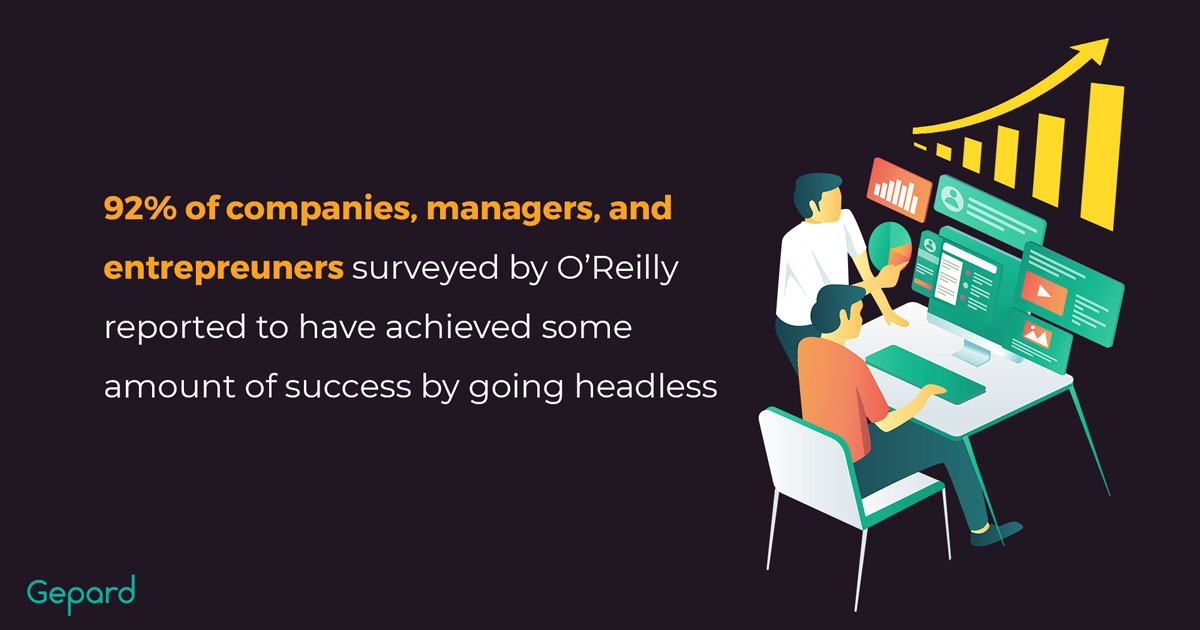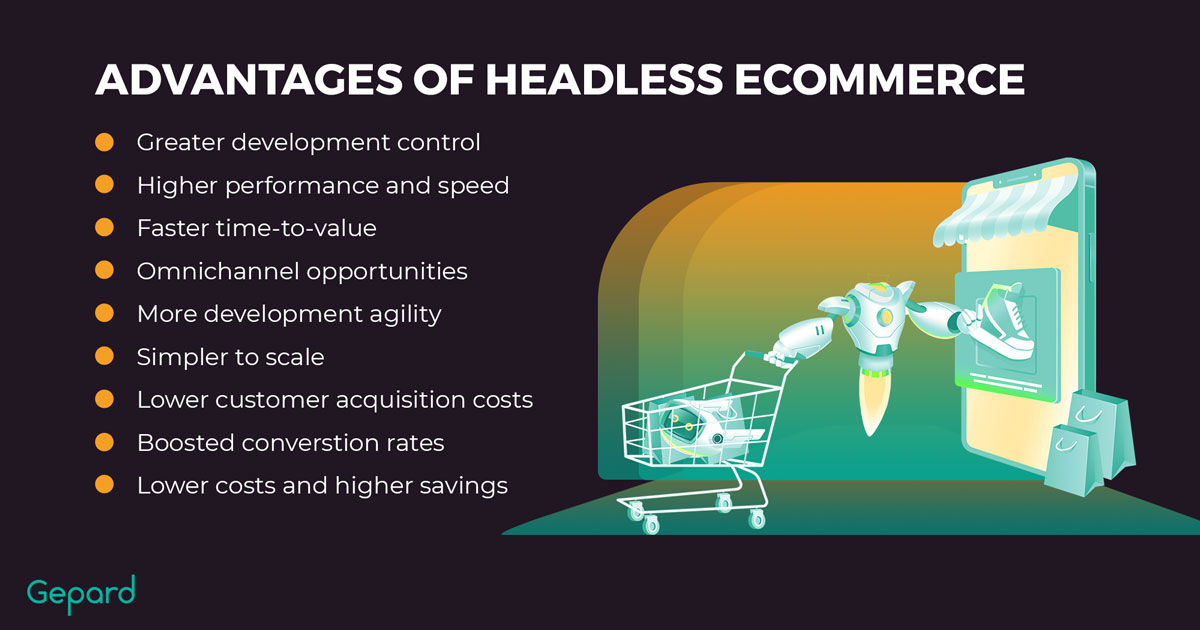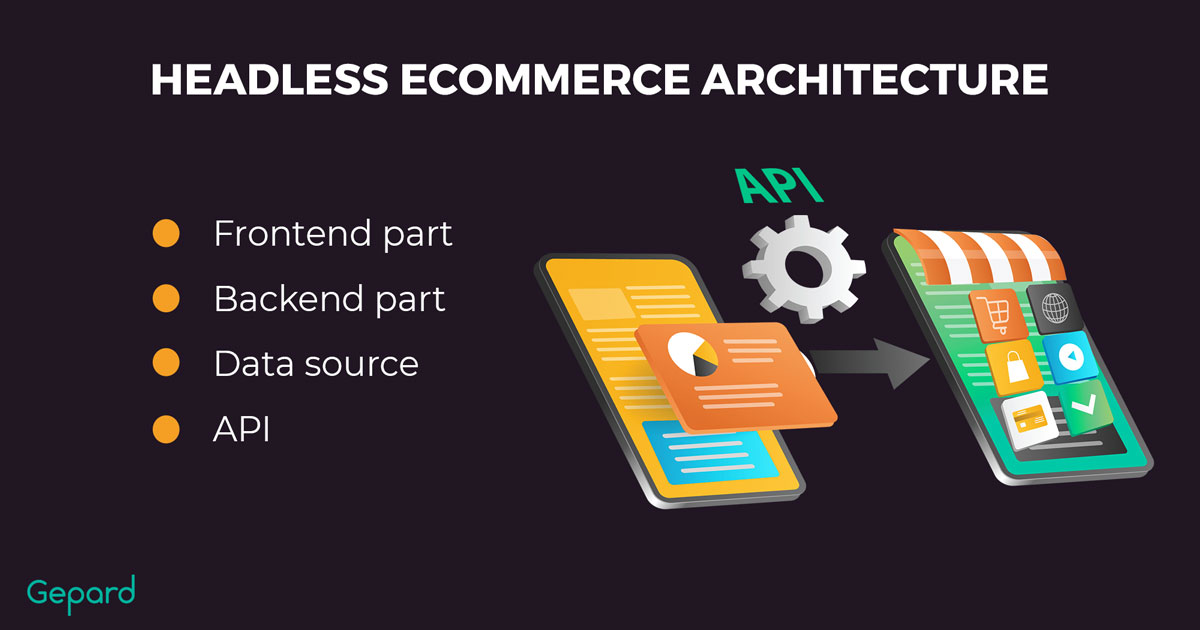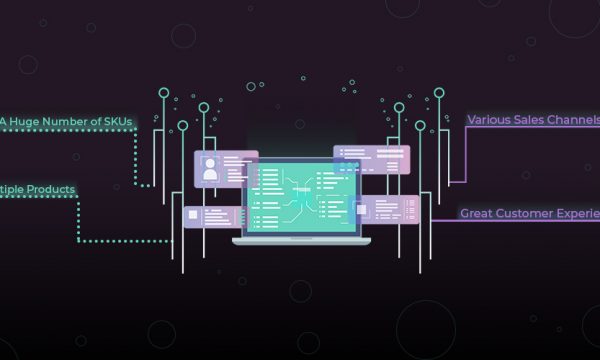Headless eCommerce: Flexible Opportunities For Your Digital Business
Headless commerce hit the market as a complete game-changer approach that enables the creation of flexible, highly-profitable eCommerce systems. It offered a unique opportunity for digitized businesses to dynamically adapt to the ever-evolving user experience demands and constraints. All thanks to an insightfully efficient method of decoupling the major parts of software systems – frontend and backend.
How exactly do the eCommerce development opportunities spawned by headless principles benefit the business, how does headless differ from the traditional approach, and what are the ins and outs of all this? Let’s figure it out.
What Is Headless Commerce All About?
Traditional eCommerce Vs. Headless eCommerce – 8 Key Differences Compared
| Capability | Traditional eCommerce | Headless eCommerce |
| Frontend Development | Limited capabilities and process control due to predefined frontend design constraints. | Limitless development potential due to the independence from frontend design constraints. |
| Customization and personalization
|
Capabilities are narrowed down by the monolithic constraints and complexity of implementing changes. | Unique, tailored results can be achieved faster and more easily. |
| Omnichannel presence
|
Limited omnichannel potential due to the complexity of connections and integrations. | Inherent omnichannel potential due to simple connections and integrations. |
| Flexibility | Limited by the frontend design constraints. | Boosted by the distributed development principle. |
| Scalability potential | Limited, complicated, resource-consuming scaling that is difficult to plan.
|
Fast, streamlined scaling opportunities. |
| Time-to-market | Time-consuming process due to the complexity and constraints of monolithic development. | Faster implementation due to the simplicity and control when manipulating created components. |
| SEO optimization | Some platforms set URL formats that cannot be moderated and it is more difficult to achieve performance rates favored by SEO algorithms. | Fast loading and high overall performance streamline SEO. |
| Cost-efficiency | Development/optimization processes are time-, effort-, and budget-intensive and can even be risky. | High performance achieved in less time and minimized risks enable cost-saving opportunities. |
Headless Commerce: Ultimate Advantages
You may already have seen from the table above how the headless eCommerce development philosophy outruns traditional processes across a number of major points and aspects. To take some numbers, 92% of companies, managers, and entrepreneurs surveyed by O’Reilly reported having achieved some amount of success by going headless. Let’s elaborate on the underlying differences and advantages to give you a fuller picture of it all.

1. Greater Development Control
Traditionally, frontend developers are limited by the frontend design constraints – a basic theme or a predefined software structure. Specialists must adapt to these limits, investing more effort into figuring out how to fill all the gaps, what tech stack to better use in which situations, etc.
With a headless approach, however, frontend developers are absolutely independent of all predefined frontend technologies, which lets them build frontends in any way they see fit, gaining more control and development flexibility in the long run.
This helps brands such as Overstock gain major conversion and revenue boosts (over 30% and 8% respectively).
2. Higher Performance And Speed
One of the main benefits of headless solutions is speedy loading, which is a major indicator of performance for SEO analyzing mechanisms, an essential KPI, and an ultimate customer conversion tool.
Traditional eCommerce development platforms commonly set performance constraints that are pretty difficult to tweak and adjust and regular website performance optimization can be overly effort-consuming.
Venus – a global provider of women’s care products we all know about – managed to fix a major performance drop on their site by going headless. As a result, a more than 50% performance increase was achieved by converting into a React PWA with headless infrastructure.
3. Faster Time-To-Value
Developing a new monolithic eCommerce solution, especially a custom, multi-functional one, is a complex, time-consuming process that can be occasionally hindered by the frontend design limitations.
Developing a headless product is faster due to the ability to create and optimize frontend components once and then freely manipulate and extend them where need be.
4. Inherent Omnichannel Opportunities
Monolith eCommerce solutions can be omnichannel only to a certain extent, limiting the outreach, accessibility, and availability of the product. Cross-platform connections and channel integrations here, again, require a more substantial effort.
A headless architecture is inherently omnichannel due to its API-powered versatility of connection and integration. The headless approach enables seamless omnichannel content publishing and an equally smooth user experience across all end-user platforms and devices.
This helped one of the largest retail chains in the world – Target – bridge the gap between channels they had been using and those they had been missing out on to achieve a unified customer experience.
Read more about building a successful omnichannel strategy:
5. More Development Agility
In single-tiered solutions, the scope of development capabilities and software customizations is narrowed down to the constraints of the underlying frontend design. In turn, the ability to build the backend and frontend parts independently provides obvious advantages of distributed work and enables the ultimate flexibility of development.
As a great instance, such flexibility allowed Nike to easily shift focus towards mobile platforms and adapt their eCommerce to streamlined mobile use on the go. As a result, the newly-introduced mobile-first approach based on the combination of React SPA and Node.js helped the company outrun its “arch-nemesis” in the market – Adidas.
6. Simpler To Scale
Scaling a single-tiered eCommerce solution is always an effort-, time-, and budget-intensive project of its own that may stretch to the extent of fully reworking and refactoring certain aspects manually while the scaling potential is limited to available business resources.
Headless solutions are fully customizable from the get-go – system expansions, integrations, and such can be implemented faster and without going through common tech pains.
These capabilities helped another renowned beauty products provider – Feel Unique – streamline the user experience and timely scale to properly serve the extremely spiking demand for their products.
7. Lower Customer Acquisition Costs
Highly engaging, individually tailored, and polished out user experiences enabled by headless development streamline traffic acquisition rates. You may focus on a high-quality delivery of headless content rather than investing loads of time and money into social media ads.
8. Boosted Conversion Rates
Due to the predefined frontend design constraints, specialists must go in-depth and rework major parts of code, database systems, and other internal aspects to make any essential changes and hit the market demand. In most traditional solutions, it is nearly impossible to achieve high performance, accessibility, uniqueness of the product, and perfect user experience all at once.
A headless approach enables developers to tailor and dynamically re-tailor unique personalized front-end experiences without going far and bothering with refactoring tasks. With an in-depth control of the development process, developed solutions can emphasize specific business attributes, fit particular requirements, and translate commercial statements in the most striking way. As a result, pinpointed user satisfaction drives conversion rates.
9. Lower Costs And Higher Savings
Developers have to go in-depth to customize and tailor the software to specific needs, tackling expertise-intensive, time-consuming, budget-heavy tasks that may also spawn extra business risks (which may generate more expenses still).
A segmented development principle minimizes the risks of technical issues, streamlines performance optimization, and enables cost-saving opportunities across a number of aspects, from streamlined scalability to shortened time-to-market.

How Does A Headless eCommerce Solution Work?
Now that you know in which ways headless stands out in terms of the surface-level benefits, let’s go a bit more in-depth technically. How do headless products actually work?
Types Of Headless Architecture
In a broad sense, headless architecture is commonly based either on an API or on microservices. The choice depends on the scope of complexity of your eCommerce solution, UI requirements, and richness of content among other things. Thus, your headless software structure can be:
- Based on an API-powered eCommerce platform – this is where you take the existing eCommerce backend that was built previously and connect it to a customized frontend through an API. This is a common choice when UI customization and tailoring are a priority while the core business logic may remain standard.
Most of the brands mentioned above in the benefits sections employ this approach, including Target and Nike.
- Based on an API-powered CMS – an approach similar to the above, but a pre-built content management system backend is connected to the customized frontend. This is usually an option for those owning a CMS-based solution that requires some eCommerce functionality. Content-rich websites that provide a scope of content management features are built by this scheme as well.
The Economist is among the most renowned users of headless CMS while even Burger King had a digital menu initiative driven by a headless CMS at some point.
- Based on specialized microservices – microservices are the underlying interconnected parts and components that make up the foundation of the whole architecture as if they were bricks. The most complex, extensive headless solutions with versatile user experiences are crafted from microservices. This is a choice for highly tailored custom products that can be shaped whichever way you need without the inherent traditional eCommerce time- and effort-consuming demands.
Multiple renowned market leaders run on microservices, such as Amazon and Etsy, with Netflix and Uber topping the list.
Headless eCommerce Architecture Example
A common headless commerce software product is built on four essential pillars:
- Frontend part – a customer-focused user interface optimized for end-user channels.
- Backend part – a business logic that outlines all internal processes as well as user interaction features.
- Data source – a connected database or a business system for storing, managing, and providing the required data for other parts of the solution.
- API – a specialized interface that connects the frontend and backend, enabling data transfer through requests and inputs.

Thus, the frontend part is first built based on the specific business and design requirements. It is then set in motion by the fitting backend business logic connected via an API and supplied with data to process and compile coming from a data source, which is connected separately.
Third-Party Integrations
Headless solutions offer great omnichannel capacities that let market players boost target audience outreach and cover more channels to engage more customers, increase conversions, and get higher sales in the long run. You may achieve the ultimate multi-channel commerce flow by integrating your headless eCommerce product with a bigger business management system, such as:
- CRM – integration with a Customer Relationship Management system helps centralize all the customer data and tie up workflows focused on engaging users and satisfying customer needs through personalization and smoothing out of the user experience.
- PIM – connecting a Product Information Management solution helps put product data in one place and more efficiently distribute it across a range of sales channels.
- ERP – integrating with an Enterprise Resource Planning system, you get to streamline a bunch of the underlying business processes through centralized management (everything from accounting and planning to staff and inventory management).
- OMS – an Order Management System integration will help you better manage orders coming from all channels you cover and avoid essential order processing errors (such as order duplication, delayed or missed fulfillments, etc.).
Benefits Of PIM With A Headless CMS
Headless CMS for eCommerce serves as an outstanding alternative to regular CMS solutions for businesses looking to step their game up in terms of versatility of processes and scalability potential. Adding the headless CMS capacities to your existing PIM system may as well be a game-changer for your business.
What Is A Headless CMS?
Any Content Management System where the content management part is separated from the user interface is a headless CMS. This is the principle of decoupling the frontend from the backend, which we are well familiar with by now. Content is delivered from the backend to the presentation layer via an API.
Leverage A Headless CMS For PIM
The main advantage of headless CMS is its multi-channel capacity. By integrating your existing Product Information Management system with a headless CMS, you can achieve multi-channel capacities that ultimately streamline outreach, engagement, and sales.
This allows you to:
- Custom-tailor eCommerce structures
Achieve an architecture that perfectly fits any type of data and data distribution principles with an ability to tailor and customize each and every part of the CMS structure.
- Get more control over content distribution
Headless content management is much easier to manage and plan out the distribution of – omnichannel opportunities combined with an intricately customized content publishing workflow make wonders.
- Expand content distribution channels
Cover as many content distribution channels as you need and decide exactly how your content looks and “feels” while a specialized API does its job delivering the content to end-users.
- Better manage content assets
Manage all documents, images, and all sorts of other content files directly and in one place. With a headless CMS, all the required content can be conveniently structured in the system and easily browsed by managers or admins at all times.
Read more about PIM usage scenarios:
Headless Commerce: FAQ
What Is A Headless Approach?
A headless approach to the development of eCommerce software enables decoupling front and backend for more versatile, pinpointed underlying processes and results. As opposed to traditional eCommerce development techniques, it enables flexible, time-, effort-, and cost-efficient opportunities for developers as well as the freedom of UI customization. It does so by eliminating the frontend/backend interdependency.
What Are The Best Headless eCommerce Platforms in 2022?
Some of the all-time leading eCommerce platforms in the market support the headless approach, including Shopify Plus, Magento, BigCommerce, Salesforce Commerce Cloud, and others.
What Is Headless PIM?
A headless PIM is a Product Information Management system built based on the headless philosophy. That means that your PIM’s backend is an independent architecture with a connected data source, data from which is delivered to the frontend presentation layer via an API (which bridges the gap between the frontend and the backend).
Headless Commerce Ins And Outs: Bottom Line
A headless strategy can make your eCommerce successful in the current harsh, highly-demanding market realities if used properly. By decoupling the foundation of your product, you may acquire unprecedented advantages and sharpen up your competitive edge without going far, spending much, or complicating things otherwise.
With that being said, we’d like to emphasize the importance of having verified, accurate, standardized, and enriched product data at your disposal. And a versatile, personalized PIM system in your market-conquering arsenal can become the cornerstone of your data management and customer servicing quality. But it’s essential that only qualified, experienced professionals, help you implement your business-boosting PIM solution.
The team of savvy professionals from Gepard PIM can help you streamline data management and achieve faster, higher, and more long-term sales.
Contact us right now to get a personalized Gepard PIM demo that shows the exact way Gepard specialists can drive your business success.







